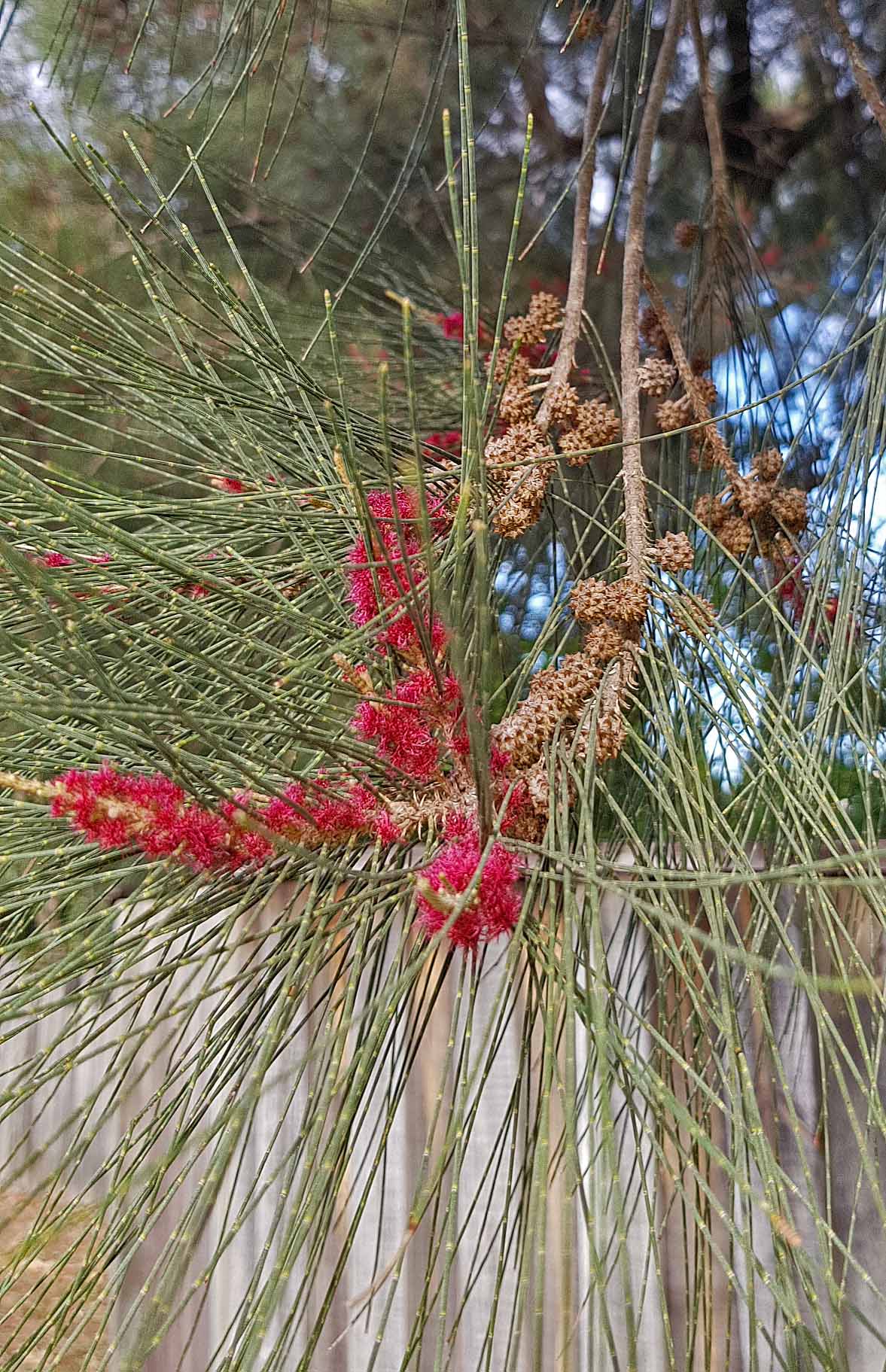Casuarina
- Family: Casuarinaceae
- Local Names: Amharic (arzelibanos,shewshewe), Arabic (gazwarina), English (Australian beefwood,Australian pine,beefwood,casuarina,coast beefwood,creek oak,Cunninghams beefwood,fire oak,river she-oak,river oak), French (casuarine de Cunningham)
Description
1. Casuarina cunninghamiana is a medium to large tree 12-35 m in height, 30-150 cm in diameter. Bark finely fissured and scaly brown. Leaves on new shoots erect. Deciduous branchlets thin and soft and droop in various specimens.
2. Leaves like teeth, less than 0.5 mm long, 6-8 in a ring at joints or nodes about 5 mm apart, on the main twigs to 3 mm long, curved back in rings close to 1.5 mm.
3. Flower clusters inconspicuous, light brown. Male and female flowers borne on separate trees. Male flowers borne in terminal spikes, 0.4-4 cm long, less than 3 m3. m wide, at the tips of shoots and arranged in whorls with 11-13 whorls per centimetre of spike; female flowers small, reddish and oval-shaped, 5 mm long. Fruiting cones are small, subglobose, about 7-14 x 4-6 mm. The individual fruit is small, pale greyish, samara 3-4 mm long, often longer than broad.
4. ‘Casuarina’ is from the Malay word ‘kasuari’, from the supposed resemblance of the twigs to the plumage of the cassowary bird. One of the common names of Casuarina species, ‘she-oak’, widely used in Australia, refers to the attractive wood pattern of large lines or rays similar to oak but weaker. The name of this species honours Alan Cunningham (1791-1839), Australian botanist and explorer and superintendent of the Botanical Gardens at Sydney.
Ecology
1. In its native range in Australia, C. cunninghamiana is found mainly in the warm subhumid climatic zone. Some coastal localities are in the warm humid, while farther inland some populations are in the semi-arid zone. Populations at higher altitudes in New South Wales tolerate up to 50 frosts per year and temperatures as low as -10 deg. C. Northern coastal localities are frost free.
2. C. cunninghamiana is generally a dominant species in riverbank vegetation. It is restricted to river- and streambanks and adjacent valley flats, and may extend for a short distance up rocky hillsides above watercourses. Moderately tolerant of saline conditions; however, under natural conditions, where the water becomes brackish in coastal rivers, C. glauca usually replaces it. It also becomes chlorotic on highly calcareous soils.
3. It is moderately drought resistant but is unable to tolerate semi-arid conditions unless some additional groundwater is available to supplement rainfall. It is relatively fire sensitive especially when young. When planted outside its natural habitat, it adapts itself to comparatively dry sites.
Native range
Australia
Tree Management
1. C. cunninghamiana is a long-lived, relatively fast-growing tree with average height increments of 1-2 m/year. Seedlings require protection from browsing stock and fire in initial stages of growth. It displays fairly good coppicing ability when young, and older trees are capable of producing root suckers. When introduced to exotic localities, inoculation of the seedlings with pure culture of effective strains of Frankia rhizobia is recommended to enable the species to fix atmospheric nitrogen.
2. Seed storage behaviour is orthodox; storage in complete darkness appears to retard germination. There are an average of 607 200 viable seeds/kg.
In its native range in Australia, C. cunninghamiana is found mainly in the warm subhumid climatic zone. Some coastal localities are in the warm humid, while farther inland some populations are in the semi-arid zone. Populations at higher altitudes in New South Wales tolerate up to 50 frosts per year and temperatures as low as -10 deg. C. Northern coastal localities are frost free.
3. Casuarina is generally a dominant species in riverbank vegetation. It is restricted to river- and streambanks and adjacent valley flats, and may extend for a short distance up rocky hillsides above watercourses. Moderately tolerant of saline conditions; however, under natural conditions, where the water becomes brackish in coastal rivers, C. glauca usually replaces it. It also becomes chlorotic on highly calcareous soils.
4. It is moderately drought resistant but is unable to tolerate semi-arid conditions unless some additional groundwater is available to supplement rainfall. It is relatively fire sensitive especially when young. When planted outside its natural habitat, it adapts itself to comparatively dry sites.
5. The optimum temperature for germination is 30 deg. C. Propagation is usually from seed, since seed production is so prolific and germination occurs easily. If selected pure cultures of Frankia rhizobia are not available, it is advisable to inoculate seedlings with a suspension of crushed nodules collected from the host tree, preferably at the original collection site. This will improve seedling establishment and ensure rapid growth during the initial stages of plantation. Vegetative propagation by air layering has been attempted with limited success. Treatment of terminal branchlets, heel cuttings or basal sprouts especially from juvenile plants with root-inducing hormone powder has proved more successful. Cuttings should be maintained on a mist bench with bottom heat.
Timber
Sapwood is narrow and pale with dark reddish or purplish-brown heartwood. In Australia, the wood has a reputation of being moderately strong but tough and fissile, fine-textured, straight-grained and with wide medullary rays. It is hard to work and dress but takes a good polish, with a green density of 800-900 kg/cubic m. It requires care in gluing and preboring is necessary for nailing. Heartwood is extremely resistant to preservative treatment but is durable and may last for 15-25 years in the ground. It has been used for panelling, furniture, casks, axe handles and ornamental turnery, as well as general utility farm timber. In Argentina, it is recommended for use in parquetry flooring, packing cases, veneer and barrels. Its utilization as sawn wood is limited by its tendency to warp, twist and split during seasoning.
Shade or Shelter
Medicine
Gum or Resin


